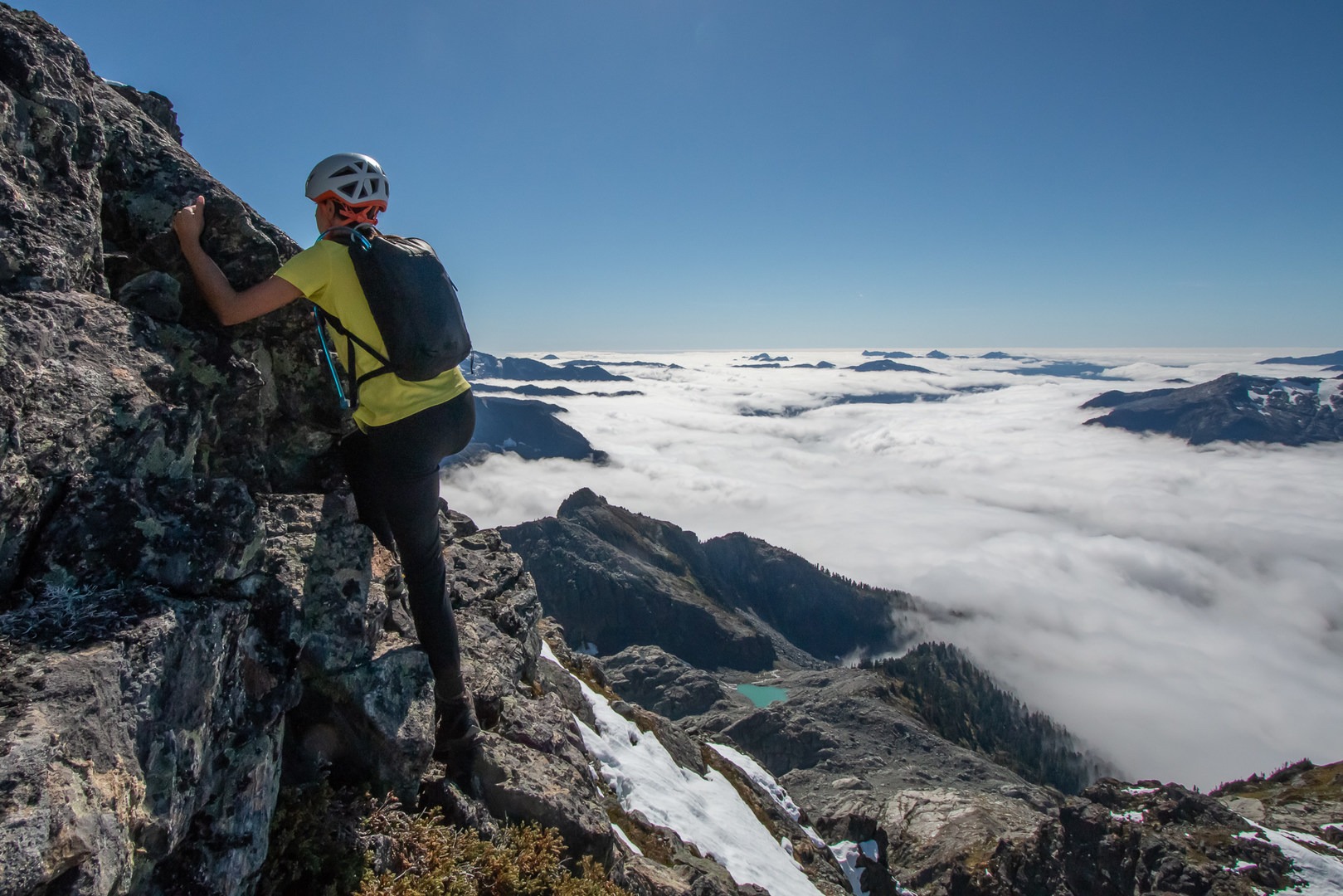You are here
Mount Ossa is one of the best Scrambles in the Coast Mountains. While the approach is gruelling and time consuming it is absolutely worth it for the sustained exposure and excellent quality third and fourth class scrambling. This route is similar to Sky Pilot but with less exposure and an easier crux. It is a really good place for an experienced backpacker to start experimenting with mountaineering because it requires good navigation and some comfort with exposure as opposed to advanced climbing skills. For information on the hike in to Mount Ossa Meadows, check here. An early morning start is recommended for this route. Some of the route finding can be tricky, and it's a long hike out.
The trail is decently marked as it heads uphill out of Three Lakes. Triangular trail markers are replaced by taping. In the fog it can be a bit tricky to find your way as much of trail gets swamped over by water. Eventually you break out into a meadow with a rocky creek on the southeast end. Wander through this for 200 meters. You'll be tempted to follow three orange markers to the right on the steep boulder patch heading into a heathery hill above. This may be marking for a future trail, but it certainly doesn't go right now.
Continue up the creek to a semi-permanent snow patch and big open bowl. There are cairns, but the general gist is to follow the boulders as they do a "J" turn up into the cliffs. It gets a little steep, but never so much that you would defintiely need to use your hands. This curves up toward the ridge first into bigger boulders before getting to grassy knolls. A few solid cairns and occasional tape makes the route finding easier, but for the most part you'll stick to the ridge. Once above, a large clump of snow and talus does require taking a short 20-meter gulley east side of the ridge. It is not a massive feature, but when you approach the challenging climbing, it should reveal itself as a much easier option.
Once on the ridge the route involves lots of steep hiking. From this vantage point it appears that there are two peaks to Ossa that are almost identical in height. The first appears daunting, but it shrinks as you approach. In the center of this ridge is a buttress, and you may be able to spot the cairn sitting on top of it. This feature is the first one to follow. The exposure begins here, but if you keep an eye out for good footholds you'll find that the route is not too arduous. There are only a couple of spots where you might have to edge your foot delicately, but none of them are sustained.
The top of the buttress is fairly broad and makes for a good spot to stop and take stock of the route. The route is less steep here, and if there is snow, an ice axe is certainly useful. This section weaves up and then follows a bench across a gulley. You can opt to go left toward the top of this for a quick fourth class step that avoids the exposure.
As you stand on the first summit it becomes apparent that the true summit is indeed much higher than the first. The broad ridge makes for easy terrain to cross before you work your way up the bouldery face of Ossa. Without snow this would be enjoyable third class scrambling with just the right amount of expose; with snow it can be a bit of a slog.
Eventually the route steepens as you approach a gendarme of sorts and a obvious "V" between boulders with cairn leads you to the crux. It is actually not super steep descending down. The challenges comes in getting into the gulley itself. There is one committing step with footholds that are tricky to find, but once you're there you can hop across to a grassy ledge that takes you into a gully. By far the most enjoyable scrambling is here. This terrain is very reminiscent of Sky Pilot's summit section, with good third and fourth class moves and mostly solid feet. The route mostly goes straight up, and there isn't much room to wander. It brings you to the summit ridge, which is broad, and it's a short walk to the true summit.
One wonderful aspect about this scramble is that all the ridge sections offer a great chance to relax as they flatten out. Even on the summit you are greeted with a feeling of security. For an experienced backpacker looking to get into scrambling and mountaineering who is wanting to push their exposure, this is a marvellous choice.
The terrain on the descent feels less scary, and the holds are familiar. Of course this can lead to complacency, descending Ossa can be far more enjoyable and comfortable than ascending. The crux is significantly easier to go up than down, and from there the best routes become obvious. It is a pounding descent though, so trekking poles become handy pretty quickly to preserve your knees.
Gear recommendations
- Helmet
- Ice axe in fall if it has snowed
- Boots or shoes with edging
- Gaiters if there is snow
- Usual scrambling equipment
- Ultralight camping gear (It's a steep hike in with a lot of elevation gain. Being careful with pounds will serve you well.)
Logistics + Planning
Current Weather: Powered by Dark Sky





























Comments
Sign In and share them.